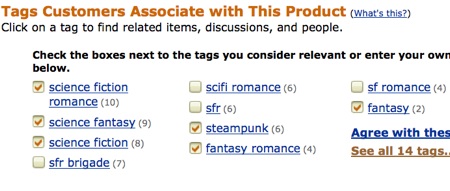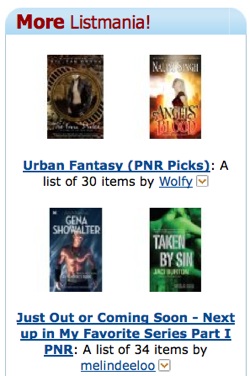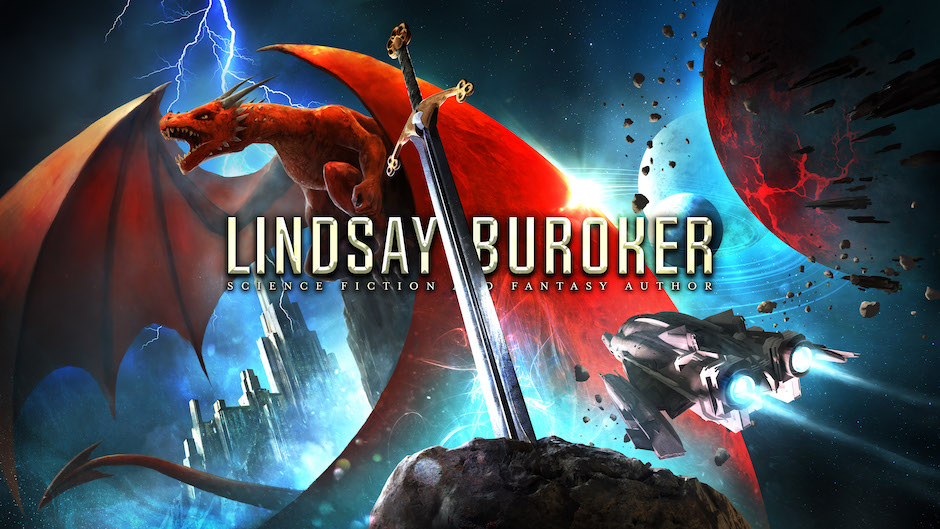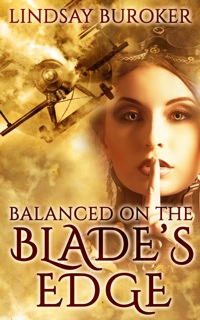If your books are languishing in obscurity at Amazon, and you’re sure folks would love them if only they could find them, there are a few marketing tactics you can try on the Amazon site itself.
I’ve done some of these things, and my sales-per-day average has been increasing, but I’m not sure how much, if any, credit to give these tactics. The reviewers who mentioned how they came across my books cited other sites — reviews, Twitter, guest posts, Goodreads advertising, etc., so I’m not sure if anybody stumbles across my work while browsing Amazon or not.
Either way, these little tricks are easy to implement, so there’s not much to lose. And who knows? Maybe they’ll help a smidgen.
Using Keywords in Your Title Space

Out of everything I’ll mention here, my guess is this could do the most for you. Amazon, Barnes & Noble, and Smashwords all currently let you add words to the title that aren’t necessarily on the cover of the book. Some authors are sticking their genre, or keywords related to their book, into the title space, so their piece will come up if people search for those things on the site.
Examples:
- Monique Martin’s Out of Time: A Paranormal Romance
(currently #1 in the search for paranormal romance)
- H.P. Mallory’s Fire Burn and Cauldron Bubble, a Paranormal Romance (Jolie Wilkins Series, Book #1)
(#4 for paranormal romance)
- H.P. Mallory’s To Kill A Warlock, an Urban Fantasy (Dulcie O’Neil Series, Book #1)
(#1 for urban fantasy)
The books in these examples are by indie ebook authors, and they’re selling a lot of copies. The books have also been out a while, they have good reviews, and they’re priced low ($0.99 for the top two and $2.99 for the last), so I’m sure it’s not just the use of keywords in the title that’s moving these titles, but this is something that probably won’t hurt and could help, especially if you write in a popular genre.
My books don’t fall into neat genres or sub-genres, but I decided to give this a try anyway. You can see the picture for Encrypted up there, and my other novel is listed as The Emperor’s Edge (a high fantasy mystery in an era of steam) on Amazon and Barnes & Noble. “High Fantasy” was the keyword I wanted in there, and I used the rest to describe the novel briefly. Someone finding your book via the search results will only see the title, your name, the price, and a thumbnail of the cover, so sneaking in a mini blurb might help them decide to click yours over another that’s more vague.
My ebook does actually come up on the first page results (as I’m typing this anyway) for “high fantasy,” but I doubt that’s something many people type into the search box. I’m skeptical that many people look for books by searching by genre (though it’d sure be interesting to get a copy of Amazon’s web statistics to find out!), but, again, it probably can’t hurt to do this.
Do you need to? Obviously not, since there are tons of bestsellers who don’t. Indie phenom Amanda Hocking’s first book is simply My Blood Approves.
Getting Tagged on Amazon

If you’ve done reviews, or you’ve memorized every pixel on your book’s Amazon page, you’ve probably noticed the “tags” or keywords that people can plug in to help categorize a book. As with using keywords in the title, these tags help the internal search engine find relevant results to display when someone types in “paranormal romance” or “urban fantasy” or what have you.
I’ve seen numerous tag-me-and-I’ll-tag-you threads on discussion boards, and I’m not sure how I feel about asking people who haven’t read the book to do this, as it seems like gaming the system. But you could probably argue that is true for everything in this blog post. Ultimately, you’ll have to decide which of these tactics you’re comfortable with. I’ve noticed some authors ethics tend to become a little more pure after they’ve established themselves and can count on regular sales. *innocent whistle*
You can tag your own books once, so make sure to do that. It’ll give reviewers some guidelines when it’s their turn to tag.
As to how effective book tagging is, I don’t know. Based on my Google SEO knowledge, I’d guess there’s more weight to having your preferred term in the title, but the tags might help you show up across a number of sub-genres. The Emperor’s Edge has been tagged most often with “steampunk,” and the novel does show up on the forth page of results for that term. Of course, not many people are going to click through four pages of results to find a new book to read, but since I don’t use steampunk anywhere in the book description or title, it suggests tagging does help (note, a number of reviewers used the word steampunk, and that may have some weight in the Amazon search engine as well).
Note: Tag your book on Amazon UK as well as the regular Amazon site (the tags don’t automatically carry over).
Get Listed (Amazon Listmania Lists)

You’ve no doubt seen Amazon’s “listmania” lineups; these reader-created lists of books show up all over the site, usually for a certain genre or about a specific topic. They show up on specific book pages if that particular book is in the list.
Fans create lists for fun; you can create them for marketing purposes (it’s okay if you have fun doing it).
The idea is to list your book with other popular titles that are similar in genre/style/theme. If you have a YA fantasy, for example, you might want to include your offering and other related ones on a list that mentioned Harry Potter and other bigwigs in the field.
I did a list for one of my books when I first published it, and then I promptly forgot about it. I imagine it helps if you plug your list various places and routinely add to it. I must admit, it did feel a tad…lame (yes, that’s the big, impressive vocabulary word I’ll use) to make a list and put my book at the top. Once we’re popular and well-loved by more than three people, maybe folks will create lists for us.
Here’s a nice writeup with some tips for creating Amazon lists for book promotion purposes.
So, there you are: three marketing gimmicks to try at Amazon. Keywords in titles, tagging, and listmania lists.
In the end, it’s hard for me to conclude whether these tactics have more than minimal impact (I’d love to hear your thoughts in the comments below), since I’m doing a number of things for promotion and no one has yet said, “Hey, I found your novel by typing in steampunk on Amazon,” or “I saw you in a science fantasy romance list,” but none of them take a lot of time to implement, so if something sounds appealing, you can give it a try.




Interesting post and helpful. A question about the first option of tags. Is this something you set up initially or can you go in and tinker with it after the book is up?
Thanks,
Nancy
Thanks for the tips. One could argue that even if the impact is small every little bit helps.
Nancy, I believe you can change your tags any time (I know I’ve added more, but I don’t think I’ve deleted any yet…I want to say there’s a max of eight or so that you can enter), though you’re stuck with what other people give you!
You’re welcome, Patricia. Thanks for commenting!
great ideas. I do the last two already, but had not known about the first.
Hey Lindsay,
Great suggestions! Question: Are Listmania lists accessible independently of Amazon’s site? In other words, could a Listmania list be directly linked from a web site as a means of referring traffic to a number of books at once?
Heavycat, I’m not sure if you can grab the contents of a list (easily) for use on another site, though I do know you can create an affiliate link that goes to the list page if you want to send traffic to it and (maybe) make some money if someone buys a book from the list.